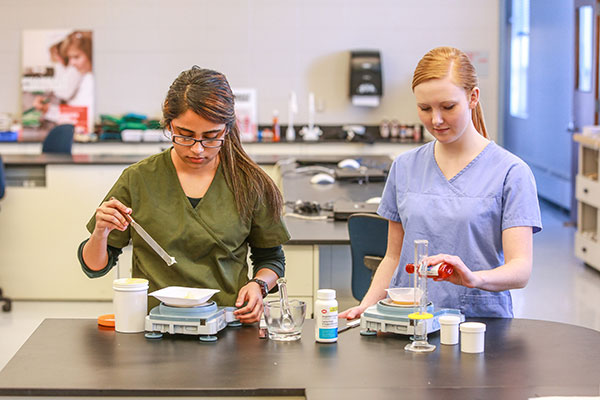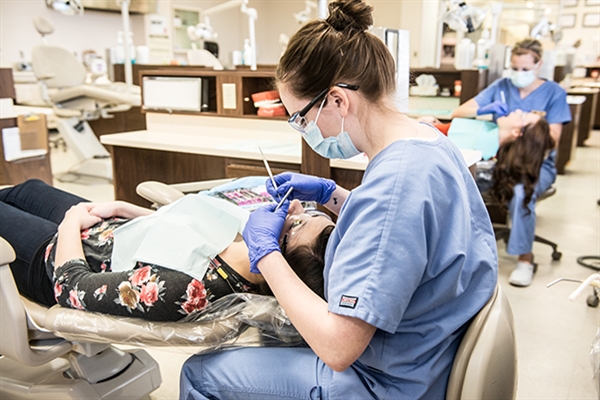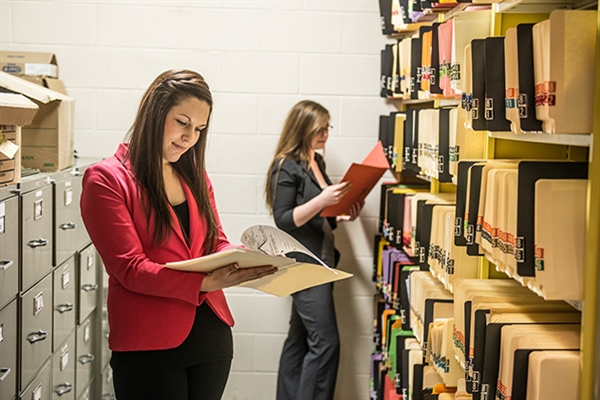On this page:
Overview
Our dynamic and practical Pharmacy Assistant program is designed to equip you with the essential skills needed in modern pharmacies. As pharmacies become increasingly central to community health, especially with an aging population, the role of the pharmacy assistant becomes more critical.
This program offers comprehensive training, broad theoretical knowledge and practical skills like preparing prescriptions, managing inventory and customer service. You will learn to be an effective team member, providing critical support to pharmacists and pharmacy technicians.
As a student, you will:
- master the math required for accurate medication dispensing
- learn about pharmacotherapy, which is the understanding of medication uses and effects
- learn to handle prescriptions and patient orders efficiently
- acquire administrative skills crucial for pharmacy operations
- get hands-on experience in preparing custom medication mixtures
- develop strategies to maintain optimal stock levels
- enhance your ability to interact with customers and healthcare professionals.
You will apply your learning in a real-world pharmacy setting during your practicum.
By the end of this program, you will be prepared to step into a pharmacy assistant role, providing vital support to ensure the health and well-being of the community.
Whether you want to start a new career or advance in the healthcare sector, this program offers the foundation to succeed.
Pharmacy assistants tend to be methodical, innovative and objective.
You need:
- fine motor skills and manual dexterity
- composure and the ability to regulate your emotions in stressful situations
- a caring attitude toward others
- effective communication skills
- mental alertness while doing routine tasks
- attention to detail
- the ability to type 35 words per minute accurately.
Pharmacy assistants work on their feet and perform repetitive movements with their hands, wrists and arms for prolonged periods. Some positions require extended hours and shift work, including nights and weekends.
You are strongly encouraged to refer to the ALIS website for career, learning, and employment information for pharmacy assistants to ensure you can successfully meet the occupational requirements for the program and profession.
You'll participate in a practicum during your second semester, where you'll apply your knowledge and skills in a pharmacy setting with a designated clinical partner.
You will be assigned practicum placements with consideration given to your preference of location. However, due to limited availability in Calgary, it might be necessary for you to travel or relocate outside the city.
The healthcare field has a strong focus on health, wellness, and fitness to practice due to the demanding nature of the work and Occupational Health and Safety requirements. As such, special considerations will not be granted based on individual circumstances or preferences, except those stated as protected grounds when an accommodation has been approved.
In compliance with the practica agreements with our clinical partners, you will be required to provide specific documentation before you can participate in your practicum. Find out what requirements you need for this program.
The spring (May) intake for this program is reserved for applicants currently residing in Edmonton and rural Alberta, who can provide proof of their home address. All practicum placements will occur within Edmonton and rural Alberta.
In this intake, you'll attend your lectures online and labs on campus and complete a practicum placement. To accommodate those with significant distances to travel, on-campus lab days will be scheduled in groups of four to five consecutive days and occur approximately once per month.
Practicums will be arranged outside the Calgary area in collaboration with SAIT's partner pharmacies. Though the location is not guaranteed, you are encouraged to consider your ideal practicum location beforehand. There is a high demand for pharmacy assistants in Edmonton and the surrounding area.
Upon successful completion this program, you will be awarded a SAIT Pharmacy Assistant certificate.
Careers and opportunities
Each year, SAIT conducts a survey between February and April to determine the employment rate, salary and satisfaction of our newest SAIT alumni.
![]() 92% graduate employment rate
92% graduate employment rate
![]() $35,360 average starting salary
$35,360 average starting salary
Find out more about our graduate employment statistics >
Our graduates may work in the following occupations. Some careers require additional experience and education.
Associated National Occupational Classification (NOC) codes: 32109, 32124, 33103, 33109.

Career planning support
Unsure which career path is for you? Here are some recommended career planning resources to help you decide your future.
You can also head to Alberta alis for lots of information about careers in Alberta, including quizzes and labour market information to help you narrow down a path.
Finally, you can take our online career finder quiz, which can help narrow your options based on your current skills and interests.
Courses
The Pharmacy Assistant certificate requires 24 credits (10 courses) to complete.
The program spans 24 weeks, over two semesters.
| Course | Credits |
|---|---|
|
This applied computer course provides students with critical electronic communications, data and file management skills, along with a strong focus on using common productivity applications to format, calculate, analyze, visualize, and present or report data and information. Equivalents:
|
1.5 |
|
In this course, students develop proficiency, accuracy and efficiency in the essential calculations used in pharmacies. Students review basic mathematical principles, including fractions, measurements and conversions, and apply them in pharmacy-specific situations. |
3 |
|
Students will encounter complex patient scenarios and apply problem-solving and decision-making skills to determine which pharmacy services to provide. They will practise compounding and preparing compliance packaging. Students will also investigate inventory management and safety practices in a health-care setting. Corequsites:
|
3 |
|
In this course, students will look at the roles and responsibilities of a health-care team, and study techniques for handling workplace conflict. Students will also examine assistive devices used in home care and the third-party insurance plans related to them. |
1.5 |
|
In this course, students will develop the skills required to complete prescription transactions. In a lab setting, they will perform pharmacy operations related to analysis, data entry, insurance, prescription preparation and patient interaction. Corequsites:
|
3 |
|
This course explores basic anatomy, physiology, medical conditions and medical terminology. Students will explain basic pharmacology concepts related to body systems. These concepts include the generic names, trade names, therapeutic uses, and side effects of commonly prescribed medications. In addition, students will interpret abbreviations and symbols used to write prescriptions. |
3 |
|
Focusing on efficiency and accuracy in a lab setting, students will apply problem-solving and decision-making skills to prepare a variety of prescriptions. They will demonstrate proper pharmacy workflow and patient interactions through simulations and complex scenarios. Pre-requisites:
Corequsites:
|
1.5 |
|
In this course, students will apply pharmaceutical product knowledge to review prescriptions. They will also examine the range of pharmaceuticals that do not require a prescription and explore institutional pharmacy practice. In addition, they will analyze patient eligibility for pharmacy services. Pre-requisites:
Concurrent Prerequisite
|
1.5 |
|
In practicum, students apply their knowledge, skills and attitudes in a pharmacy setting with a designated clinical partner. Students have an opportunity to interact professionally with health-care teams and patients to process prescriptions and provide patient care. Students will experience routine practices as they relate to patient and health-care practitioner safety. Reflective learning practices are also incorporated into this practicum experience. Pre-requisites:
Corequsites:
|
3 |
|
As future health-care professionals, students need strategies for working effectively, respectfully, ethically and legally in interdisciplinary teams. In this course, they will explore decision making, ethics, team dynamics, cultural awareness, interpersonal style and communication in the health-care setting. In addition, they will review laws and regulations related to the practice of pharmacy. Pre-requisites:
|
3 |
Progression
You must attain a PGPA and/or a CGPA of 2.0 or better each semester and pass the prerequisite courses to progress through the program.
To qualify for graduation, you must pass all courses, attain a CGPA of 2.0 or better and complete course requirements within the prescribed timelines.
Review our grading and progression procedure >

Explore your options!
Some courses in this program are available through Open Studies. You can complete courses via Open Studies to get a head start on your education, reduce your course load once accepted into a credentialed program, or determine which career path best suits you before you fully commit.
You may also take courses for general interest or personal and professional development.
Admission requirements
Applicants educated in Canada
All applicants must demonstrate English language proficiency and meet the following requirements or equivalents with an overall average of at least 60%:
- Math 30-1 or Math 30-2, and
- English Language Arts 30-1 or English Language Arts 30-2.
SAIT accepts high school course equivalents for admission for applicants educated outside Alberta.
All applicants who were educated outside of Canada must demonstrate English language proficiency and provide proof they meet the program admission requirements outlined above with an international document assessment. Find accepted educational documents and assessment options.
SAIT may also accept courses completed at certain international post-secondary institutions.

Academic Upgrading
Missing an admission requirement for this program? Upgrade your prior education to help you receive admission into one of SAIT's career programs.

English language proficiency
All applicants must demonstrate English language proficiency prior to admission, including students educated in Canada.
Transfer agreements
At SAIT, we evaluate post-secondary credit you have previously earned and apply it to your SAIT credential. Explore our formal transfer agreements available for this program.
We can evaluate your prior education, even if we don't have a formal agreement in place.
Submit a transfer credit application
There are no formal transfer agreements currently in place for this program.
Transfer options for graduates
Build on the knowledge you’ve learned at SAIT. The opportunity to advance your education at an accredited post-secondary institution may be available.
🔗 Visit Transfer Alberta search tool for all transfer agreements in Alberta (including UCalgary, MRU and BVC).
If there are transfer agreements with other institutions outside of Alberta, nationally or internationally, they will be listed below.
Available intakes
Spring 2025
Start dates:
- Domestic students: Waitlisted
-
-
Application deadline: April 30, 2025
-
Fall 2025
Start dates:
- Domestic students: Open
-
-
Application deadline: June 30, 2025
-
Winter 2026
Start dates:
- Domestic students: Open
-
-
Application deadline: Oct., 24, 2025
-
Spring 2026
Start dates:
- Domestic students: Open
-
-
Application deadline: April 30, 2026
-
Costs
2025/26 tuition and fees
The following estimated costs are effective as of July 1, 2025.
The estimated total cost of tuition and fees is based on the suggested schedule of study. Following a modified schedule will impact the fees you pay per semester and may alter final costs.
Domestic students
Books and supplies are approximately $500 per full-time year.
This is a bring-your-own-device program with a standard computer hardware and software requirement. See the specific requirements on our computers and laptops page. Your device must be portable. An Android laptop or tablet is needed as the software used in this program is not compatible with Apple products. Phones are not suitable alternatives.
Find your booklist on the SAIT Bookstore's website. Booklists are created by semester and available approximately two weeks before classes begin.
Required personal protective equipment (PPE)
You are required to wear scrubs to your labs. Scrubs must be cleaned and pressed.
Additional fees
- A fee is associated with obtaining a police information check, including a vulnerable sector check, payable to the police or the Royal Canadian Mounted Police (RCMP).
- A fee of approximately $50 to $100 is associated with an electronic student permit checking submission required for clinical practicum placements, payable to Synergy Gateway through the Verified software platform.
- You are responsible for additional expenses related to your practicum, including pre-practicum requirements and relocation costs to practicum sites outside of Calgary.

Financial aid
Paying for your education may feel overwhelming, but we have resources and programs that can help, including information about payment options, student loans, grants and scholarships.
This program is eligible for Canada Alberta Job Grant funding.
Application process
Ready to apply?
Follow our step-by-step guide to submitting a successful application.
Communication during admission
Email is the primary source of communication during the admission process. Ensure your personal email account is managed appropriately to receive our emails, files and communications.
We recommend you add hps.info@sait.ca domain to your safe senders' list or you risk missing critical email messages.

Begin your application
Apply now using the online application portal.
Ensure you have a valid Visa or Mastercard to pay the non-refundable application fee of $120 for domestic applicants.
Information sessions
Prepare for a strong start in your chosen program or get the details you need to decide your future path.
Our expert staff and faculty are ready to answer your questions and provide information about the following:
- What sets SAIT apart
- An introduction to the program and area of study
- Admission requirements
- Future career paths
- Information on the earning potential and graduate employment rates.
Contact us
School of Health and Public Safety Advising
-
Email - hps.info@sait.ca
Subscribe for updates
Your journey starts here! Sign up to get important updates on:
- Health and medical programs
- Application information
- Relevant news and events

Oki, Âba wathtech, Danit'ada, Tawnshi, Hello.
SAIT is located on the traditional territories of the Niitsitapi (Blackfoot) and the people of Treaty 7 which includes the Siksika, the Piikani, the Kainai, the Tsuut’ina and the Îyârhe Nakoda of Bearspaw, Chiniki and Goodstoney.
We are situated in an area the Blackfoot tribes traditionally called Moh’kinsstis, where the Bow River meets the Elbow River. We now call it the city of Calgary, which is also home to the Métis Nation of Alberta.




